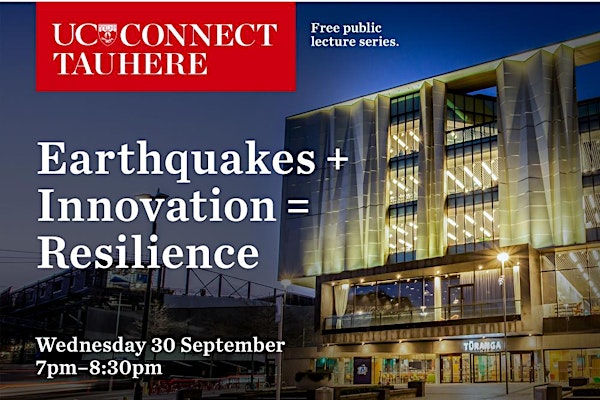
UC Connect panel: Earthquakes + Innovation = Resilience
Presented by: Panel discussion with Geoff Rodgers, Geoff Chase and Alessandro Palermo, UC EngineeringUniversity of Canterbury (UC) Engineering technology is being used to quake-proof buildings, build the “Ferrari of bridges”, and predict the future in order to save lives in these shaky isles and around the world. An expert panel will discuss how they helped to engineer world-first quake-resilient buildings and structures, in an upcoming free UC Connect public talk on the evening of Wednesday 12 August. The upcoming talk, UC Connect: Earthquakes + Innovation = Resilience will feature three revolutionary, award-winning UC academics – Distinguished Professor Geoff Chase, Professor Geoff Rodgers and Professor Alessandro Palermo. Each professor will highlight a different aspect of structural earthquake engineering advances made and lessons learnt, following the Canterbury earthquakes. Their talks will include an overview of some of the new resilient structures built using their novel solutions, such as state-of-the-art seismic dampers, and techniques, like in-silico “virtual buildings”, helping to engineer a more resilient future. Professor Geoff Rodgers, Mechanical Engineering; QuakeCoRE, University of Canterbury Professor Alessandro Palermo, Civil and Natural Resources Engineering; QuakeCoRE, University of Canterbury. My area: Energy dissipation to enable and support low-damage seismic design “The ability to create buildings that are more resilient to large earthquakes is the goal of academic researchers as well as practicing engineers. In lieu of damage to structural members and contents, we need to provide alternative forms of energy dissipation to damp building motion and absorb the significant energy imparted into a building during a large earthquake. A suite of different energy dissipation and bracing elements have been developed to enable a broad range of potential applications in different structures. I will speak on the deployment of UC research outcomes in three different buildings – two within the Christchurch CBD rebuild (Forté Health and Tūranga central public library) and one in San Francisco (Casa Adelante affordable housing) in the United States. As well as being a fantastic public asset and a focal point of the rebuilt Christchurch CBD, the Tūranga library building has won numerous industry awards for the resilient seismic design. Likewise, despite being a tightly budgeted community housing project for low-income, senior and formerly homeless residents of San Francisco’s Mission District, Casa Adelante’s careful design and innovative thinking by the design engineers has produced a building awarded a US Resiliency Council Gold Rating for Seismic Performance. My talk will cover all three projects where the UC-developed dampers have been used, covering some of the drivers for uptake and innovative designs to achieve resilience.” My area: Low-damage design and cost-effective connection detailing for buildings and bridges. “The 2010-11 Canterbury quakes and 2016 Kaikōura earthquake highlighted difficulties in assessing and selecting the fastest, most cost-effective repair philosophy for damaged concrete bridges. After the Kaikoura quakes, over 300 bridges were assessed by authorities. One bridge almost collapsed and was replaced by a Bailey bridge, while several others near the epicentre sustained fractured rebar and massive concrete damage. Bridges adopting low-damage design are a viable alternative to seismic isolation and integrate perfectly with accelerated construction techniques which are becoming popular in high-density built environments. This presentation gives an overview of outcomes of an extensive experimental study at the University of Canterbury on different types of repairable bridge and timber connections and large-scale specimens. We’ll look at real-world applications, including the world’s first implementation on a 100-metre motorway overpass, the Wigram-Magdala bridge link which opened in 2016 – and why it’s the award-winning “Ferrari of bridges”. Distinguished Professor Geoff Chase, Mechanical Engineering, University of Canterbury My area: Monitoring performance and predicting the future for resilience “In February 2011, the seven-storey CTV building collapsed, causing 115 deaths. Our inability to adequately monitor structural damage, and thus to assess how badly a structure is damaged is a leading reason why the building was occupied that day. This part of the talk presents recent world-leading UC research on monitoring structural damage with low-cost sensors to assess damage and inform critical decision-making. It shows how this work can be extended into creating in-silico “virtual buildings” to accurately predict what would happen under the next earthquake. These breakthroughs provide foundation technology solutions for optimising earthquake preparedness and response, and creating extremely resilient future cities.” UC Connect public lecture: UC Connect: Earthquakes + Innovation = Resilience, presented by professors Geoff Rodgers, Geoff Chase and Alessandro Palermo, UC Engineering, 7pm – 8.30pm, Wednesday 30 September inTSB Space, Tūranga, 60 Cathedral Square, Christchurch Central. Register to attend free: www.canterbury.ac.nz/ucconnect For more information or to request an interview please contact: UC Communications team, media@canterbury.ac.nz, Ph: (03) 369 3631 or 027 503 0168 // // More information Michayla ClemensEvents Coordinator Email: events@cantebury.ac.nz